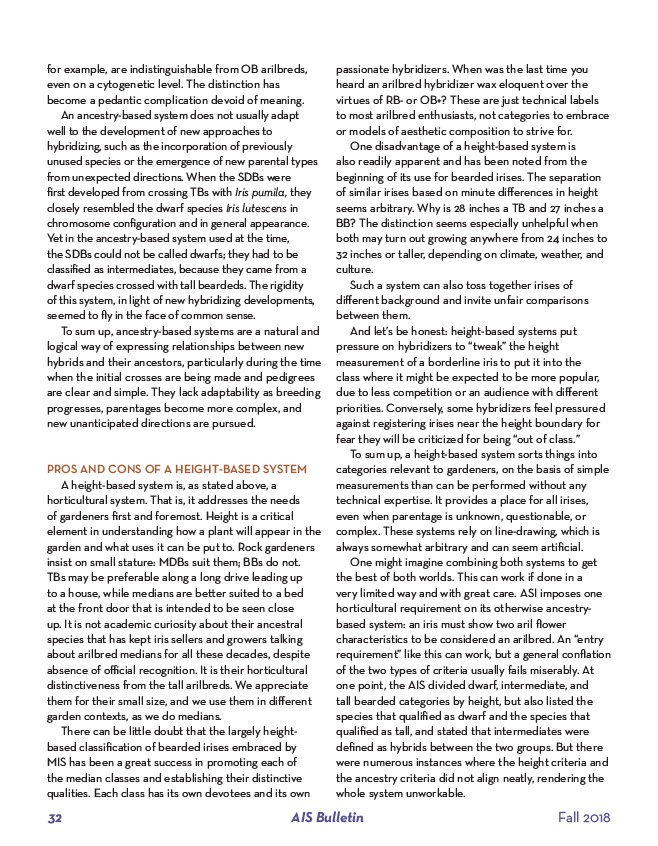
for example, are indistinguishable from OB arilbreds,
even on a cytogenetic level. The distinction has
become a pedantic complication devoid of meaning.
An ancestry-based system does not usually adapt
well to the development of new approaches to
hybridizing, such as the incorporation of previously
unused species or the emergence of new parental types
from unexpected directions. When the SDBs were
first developed from crossing TBs with Iris pumila, they
closely resembled the dwarf species Iris lutescens in
chromosome configuration and in general appearance.
Yet in the ancestry-based system used at the time,
the SDBs could not be called dwarfs; they had to be
classified as intermediates, because they came from a
dwarf species crossed with tall beardeds. The rigidity
of this system, in light of new hybridizing developments,
seemed to fly in the face of common sense.
To sum up, ancestry-based systems are a natural and
logical way of expressing relationships between new
hybrids and their ancestors, particularly during the time
when the initial crosses are being made and pedigrees
are clear and simple. They lack adaptability as breeding
progresses, parentages become more complex, and
new unanticipated directions are pursued.
PROS AND CONS OF A HEIGHT-BASED SYSTEM
A height-based system is, as stated above, a
horticultural system. That is, it addresses the needs
of gardeners first and foremost. Height is a critical
element in understanding how a plant will appear in the
garden and what uses it can be put to. Rock gardeners
insist on small stature: MDBs suit them; BBs do not.
TBs may be preferable along a long drive leading up
to a house, while medians are better suited to a bed
at the front door that is intended to be seen close
up. It is not academic curiosity about their ancestral
species that has kept iris sellers and growers talking
about arilbred medians for all these decades, despite
absence of official recognition. It is their horticultural
distinctiveness from the tall arilbreds. We appreciate
them for their small size, and we use them in different
garden contexts, as we do medians.
There can be little doubt that the largely height-based
classification of bearded irises embraced by
MIS has been a great success in promoting each of
the median classes and establishing their distinctive
qualities. Each class has its own devotees and its own
passionate hybridizers. When was the last time you
heard an arilbred hybridizer wax eloquent over the
virtues of RB- or OB+? These are just technical labels
to most arilbred enthusiasts, not categories to embrace
or models of aesthetic composition to strive for.
One disadvantage of a height-based system is
also readily apparent and has been noted from the
beginning of its use for bearded irises. The separation
of similar irises based on minute differences in height
seems arbitrary. Why is 28 inches a TB and 27 inches a
BB? The distinction seems especially unhelpful when
both may turn out growing anywhere from 24 inches to
32 inches or taller, depending on climate, weather, and
culture.
Such a system can also toss together irises of
different background and invite unfair comparisons
between them.
And let’s be honest: height-based systems put
pressure on hybridizers to “tweak” the height
measurement of a borderline iris to put it into the
class where it might be expected to be more popular,
due to less competition or an audience with different
priorities. Conversely, some hybridizers feel pressured
against registering irises near the height boundary for
fear they will be criticized for being “out of class.”
To sum up, a height-based system sorts things into
categories relevant to gardeners, on the basis of simple
measurements than can be performed without any
technical expertise. It provides a place for all irises,
even when parentage is unknown, questionable, or
complex. These systems rely on line-drawing, which is
always somewhat arbitrary and can seem artificial.
One might imagine combining both systems to get
the best of both worlds. This can work if done in a
very limited way and with great care. ASI imposes one
horticultural requirement on its otherwise ancestry-based
system: an iris must show two aril flower
characteristics to be considered an arilbred. An “entry
requirement” like this can work, but a general conflation
of the two types of criteria usually fails miserably. At
one point, the AIS divided dwarf, intermediate, and
tall bearded categories by height, but also listed the
species that qualified as dwarf and the species that
qualified as tall, and stated that intermediates were
defined as hybrids between the two groups. But there
were numerous instances where the height criteria and
the ancestry criteria did not align neatly, rendering the
whole system unworkable.
32 AIS Bulletin Fall 2018